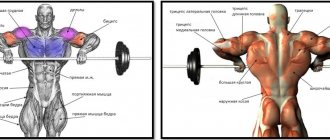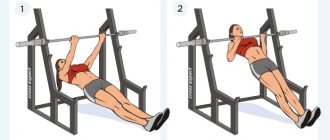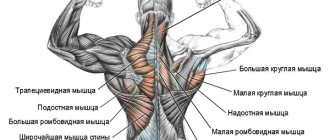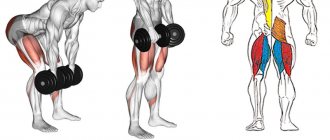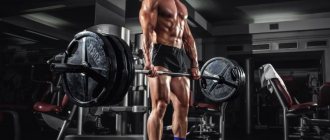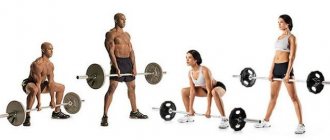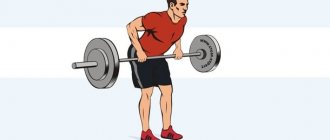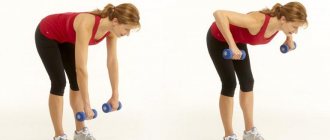Author: Timko Ilya - the ruler of the entire site and fitness trainer | more details >> Rod. 1984 Trained since 1999 Trained since 2007. Author and creator of the site tvoytrener.com. CCM in powerlifting. Champion of Russia and South Russia according to AWPC. Champion of the Krasnodar region according to IPF. 1st category in weightlifting. 2-time winner of the Krasnodar Territory championship in t/a. Author of more than 700 articles on fitness and amateur athletics. Author and co-author of 5 books.
Place in the author rating:
out of competition
(become an author) Date: 2016-08-28 Views: 15,354 Rating: 4.0
| All articles by the author >> | Medals articles >> |
Articles are loading...
Primary muscles - front of the thigh, buttocks, back extensors, trapezius, calf muscles
Additional - latissimus muscles, forearms, hamstrings, biceps
Difficulty : high
When can you do the exercise?
In scientifically based fitness, there is only one criterion - the client can perform a bend with a perfectly straight back so that the bar goes below the knees, to the level of approximately the middle of the shin. If such flexibility is not yet available, it is recommended to stretch the hamstrings, buttocks, and back muscles, as well as isolated work on the back using hyperextensions, and on the hamstrings using curls. In this case, the buttocks are pumped with reverse hyperextensions. Any beginner, with proper attention to stretching, can perform his first deadlift with a light weight in a couple of months.
Important: stretching should not be “solo” in the training plan. It is performed after a set of strength exercises on the muscles of the back and legs. The simplest stretching exercise is to sit on your buttocks on the floor and bend your body towards your legs.
In terms of training, this exercise is not the first one. For those who do not have a goal to learn basic exercises, it is placed after the leg press with medium or narrow feet. For more balanced plans - after the classic deadlift, or sumo deadlift, if it suits the athlete more according to anthropometric indicators.
It is a misconception that deadlifts “cause lower back pain.” If such pain occurs, it is necessary to exclude hypertonicity of the piriformis muscle, hernia, protrusion and pinched nerves. “You can’t just continue lifting with light weights”; you need to consult a doctor. For many people, deadlifts really help with back pain, since holding weight in this way helps to “free” the nerve roots that are pinched from improper posture during sedentary work. But no doctor will recommend you to “treat cravings,” especially if there is no accurate diagnosis.
In fitness, any back pain is a reason to exclude deadlifts from the training plan.
Anyone who doesn't have a good deadlift doesn't drink champagne.
The final chord in powerlifting competitions is three sets of deadlifts. The final result in the triathlon total depends on them. Therefore, this chord should sound very impressive. I consider this movement to be the main one in eventing, it decides whether you will be with a shield or on a shield. This means that it must be executed in such a way that there is no doubt whether it will work or not? And there must be complete confidence that if it comes to deadlifting, now there is only success. Let's rephrase: those who don't have good deadlifts don't drink champagne.
Working muscles
The deadlift is so loved by bikini athletes and their athletes for only one reason - it allows you to avoid working with the quadriceps, and therefore avoid increasing the volume of the hips “according to the male type”. In the classic deadlift, the breakdown occurs due to the quadriceps, which allow you to push off the floor. In the “dead” lift, the weight is lifted due to the work of the biceps and buttocks.
Working muscles:
- Back extensor;
- Biceps femoris;
- Gluteal;
- Soleus
The abs, latissimus dorsi, quadriceps, and oblique abdominal muscles work as stabilizers. This movement allows you to learn how to breathe correctly while deadlifting under load, but does not promote chest expansion. The muscles of the inner thighs are also included in the work during stabilization.
It's a STRAIGHT LEG DEADLIFT, baby!
Adviсe
- A good place to start is to use 70% of your normal weight for lat pulldowns.
- This exercise should be hard - and you should achieve perfect technique without losing the tempo described above.
- If you need wrist straps, use them, but only for the side you're working on.
Upper body squats, aka pull-ups, are a mainstay of back training for virtually every athlete to ever grace the competitive stage. Pull-ups are the core of special forces sports tests and the most popular exercise among fighters without rules. If these facts don't convince you to include pull-ups in your workout routine, I don't know what will!
Confusion in concepts
“Women’s and men’s” trainers are very fond of saying that deadlifts are for women. What. They can tell this to Phil Heath, who does this exercise regularly. Or the millions of not-so-famous powerlifters for whom the deadlift is the second auxiliary movement for the biceps hamstrings after the standing bend over with a barbell.
Common people often confuse:
- Deadlift, that is, deadlift with straight legs;
- Deadlift, a competitive powerlifting exercise;
- Romanian deadlift
This exercise is often called a “deadlift” in Russian coaching practice. The term came from English-language translated magazines. In Soviet textbooks on weightlifting, the movement was called “bending over with a barbell in hands”; the “Romanian” deadlift as such was not distinguished there; a similar exercise was called “push deadlift”.
For your convenience, the “Romanian” deadlift is a bent-over exercise with a barbell with slightly bent knees. Bending helps to overcome the dead point and lower the barbell lower. Therefore, contrary to popular belief, the “Romanian” is not an exercise that “isolates the hamstrings and buttocks,” but a movement that shifts part of the load to the lower back. Therefore, in scientifically based training plans, it is performed with light to medium weights, and is not used to set strength records.
The deadlift or straight-legged row is called so precisely because of the locked knees, this movement is more for the hamstrings and buttocks, and less for the lower back. The classic deadlift is different in that the weight is lowered to the floor each time and is lifted off it by pushing off the floor with your feet. It is a mistake to think that the classic deadlift is some kind of hybrid of a squat and deadlift. The angle of bending at the knees may not be large at all; the difference is in the movement, or more precisely, in the vector of application of force. The movement is initiated by pushing the legs into the floor, and always starts with the legs, not the back.
Crossfit
CrossFit training is organized on the principle of performing exercises one after another without breaks or with a second's rest, depending on the physical fitness and condition of the athlete.
Typically, CrossFit involves using multiple muscle groups with exercises such as push-ups, squats, push-ups, snatches or deadlifts. You can also use isolated exercises, but the basic program is much more effective due to the involvement of several muscle groups at the same time.
It is worth remembering that CrossFit can include exercises with your own weight (jumping, pull-ups) or aerobic exercise (cycling, rowing, swimming, running).
Important!
CrossFit advantageously combines anaerobic strength training with aerobic cardio training. The peculiarity of this type of training is the absence of a highly specialized program.
While the loads of various sports, such as bodybuilding, powerlifting or endurance racing, are narrowly focused, CrossFit involves training strength, performance and physical endurance at the same time. This feature of CrossFit training has both pros and cons.
On the one hand, a CrossFitter is universal, on the other, a specialized athlete is able to achieve greater success in his field than a CrossFitter who has included all types of training in one program.
Sports physiologists note that different types of loads, for example, weightlifting, cycling and running, included in one training program, ultimately give an average result in each individual area. It is this averageness of indicators that gives the CrossFitter the versatility so often required in everyday life.
It’s hard to imagine how a powerlifter’s ability to bench press more than 200 kilograms or a marathon runner’s ability to overcome huge distances with obstacles will be useful in everyday life.
The result of narrowly focused training is usually required during competitions, but much less often it can be useful in the rhythm of everyday life. The physical fitness a person requires every day can be achieved through CrossFit training.
That is why this type of load is successfully used in the training of professional wrestlers, military and police officers.
So, what is CrossFit?
CrossFit training involves intense exercise of various muscle groups, organized according to the principle of interval circuit training.
Source:
Execution technique
One simple life hack will help you perform this movement technically correctly. To begin, learn to lean forward with a straight back while standing on straight legs. The position of the hands is moving along the hips.
The order of execution is as follows:
- The barbell is taken from the racks with a straight grip or a lock grip; if necessary, straps are used. The grip is not a fundamentally important point of the exercise; greater concentration is required on the work of the legs and buttocks;
- While inhaling, bend forward with a straight back, due to flexion at the hip joint;
- The knee joints are straightened and “locked,” as it were; there is no need to move your knees;
- The depth of the tilt is determined by the ability to maintain a straight back; as soon as the back begins to bend in the lumbar region, you need to start moving up;
- Allowable tilt depth is any amplitude below the knee;
- Extension occurs as you exhale;
- The movement is performed the required number of times, movement in the knees is excluded;
- You should not throw your head back, you should try to keep it neutral, the neck is an extension of the spine, you should not look at the ceiling, as some athletes do when lifting heavy weights in the classical deadlift.
Important: you should not even try to lift the same weight in this exercise that you could lift in a classic deadlift.
Deadlift - execution technique.
Adviсe
- Be one of the first to do this exercise in your workout.
- Set a goal of 5-8 reps x 3 sets
- Always perform this exercise with an overhand grip for safety and effectiveness.
- Use wrist straps
This movement is from Dorian Yates's "eccentric" program. The eccentric (or negative) phase of the exercise is performed at a slower pace. Many athletes concentrate only on the positive phase of the exercise; meanwhile, it is just as important not to relax while inhaling. Do 1-count snatches and 2-count stretches to take your back muscle development to the next level.
Differences between types of traction
What is the difference in technique between types of traction? It’s strange, but all three types of deadlifts are fundamentally different in starting position and execution technique.
How is Romanian deadlift different from deadlift?
The Romanian deadlift is popularly called a lower back exercise. This is not entirely correct from the point of view of the technique, but it conveys the sensations very accurately. When the weight of the barbell is lifted on bent legs, part of the effort is given to the lower back.
Technical features:
- The barbell is removed from the racks, and after moving away, slight flexion is performed in both knee joints. The stance is symmetrical, the heels can be placed under the pelvic bones, or a little narrower, the toes can be slightly spread or left parallel, as is convenient;
- The tilt is performed by bending the hip joint while exhaling. The task of the abdomen is to keep the spine stable, so you cannot push the anterior abdominal wall forward;
- The bar slides over the body, touches it throughout the entire amplitude, there is no point in “throwing” the barbell away from the body;
- The reverse movement “starts” with contraction of the gluteal muscles, exhalation occurs with effort;
- The Romanian deadlift resembles pushing the pelvis back and bringing it toward the midline as the athlete straightens.
Romanian deadlift from the classic
The Romanian deadlift does not involve completely lowering the weight to the floor. Therefore, in strength sports it is defined as “bending with a barbell in straight arms”, and not as a “pull”. In the classics, the athlete starts from the floor, he rests his feet, tears the barbell off the platform, and lifts it, moving the bar along the body. Fixation of weight - at the top point, with shoulders pulled back. Double movement of the bar along the body, that is, movement up and down during lifting, is not allowed.
The difference between classic and deadlifts
Here the differences are obvious. A deadlift is a bend over with a barbell with straight legs. You don't have to touch the floor with the pancakes. The classic deadlift is always performed from the floor, and there is flexion in the knee joint. Some athletes find it more convenient to perform classic deadlifts from the floor from a high start. They bend their legs minimally, but this is the only way their body takes the optimal position for removing weight from the floor, and the most stable support.
Main mistakes:
- Bending the legs at the knee joint in a deadlift is a technical error. Moreover, it is not recommended to change the angle of your knees during the exercise;
- Lowering the weight due to inertia, that is, throwing the barbell down, can lead to injury;
- Rounding the spine in both the thoracic and lumbar regions is a mistake. If in a classic deadlift rounding in the thoracic region is not a technical error, and only a “hump” in the lumbar region is not allowed, then in this auxiliary exercise the back should remain straight;
- Too small a movement is not allowed when the bar does not fall below the knees;
- It is necessary to activate your back so that there is no need to throw your head when lifting the weight up;
- Most technical errors occur due to the selection of inappropriately heavy weights. It is also not allowed to “twitch” the weight with the shoulders, that is, a shrug together with a deadlift.
Adviсe
- If you do more than 30 reps, use extra weight on your belt.
- If you do less than 10 reps, use a pull-up band
- Pull up with full range of motion
- Try different variations of pull-ups. Always start with the heaviest and end with the lightest
I first saw this exercise in the 90s in one of the issues of the now defunct American magazine Powerlifting USA. It was the lifters who started doing it first - they wanted back exercises that would be done on a bench.
Which option to choose
The classic deadlift is an exercise for developing strength and growing muscle mass. Beginners are recommended to start learning deadlifts with this. The Romanian deadlift is for those who need to develop the muscles of the thighs and buttocks, plus strengthen the lower back, and the deadlift is for isolated work on the hamstrings and buttocks.
In the training plans of strength athletes, all three lifts occur to varying degrees. For a fitness specialist, the Romanian deadlift is considered the safest option, but the straight-legged deadlift is not available to everyone; it is mainly intended for people with good flexibility.
Trap bar row (trap bar)
The peculiarity of this traction is in the projectile used - it uses not an ordinary bar, but the trap bar itself. This barbell was invented and patented by Al Gerard in 1985. It was originally conceived as a multi-purpose sports equipment with which you can perform:
- – deadlift;
- – squat;
- – shrugs;
- - military press.
When performing deadlifts with a trap bar, the load on the spine is reduced. The trap bar is also convenient for beginners, since it makes it easier to maintain a strictly vertical body position and allows you to “miss” some technical points11.
There are no studies or expert opinions that can say for sure how effective or ineffective a trap bar is. However, many athletes train with it, for example, Tony Ferguson as part of the CrossFit program.
Disadvantages of the standard approach
One thing that drives me nuts is that some guys in the gym just can't grasp the basic principles. An overly stressful program is the main factor that prevents them from achieving success.
Here's an example of how they reason: “I just lifted 230kg! After a few times I’ll hit 270!”
Sorry, but first we should move on to the scales that fall between these two. These are 232, 235, 240, 250 kilograms, etc. If you lift the barbell with five weights, this does not mean that you will necessarily lift it with six! In fact, it could be a couple of years before you get to 270. And if you don't take your studies seriously, this process can take much longer.
A very modest and feasible task: increase weight by 5 kg every three months. This is 20 kg per year, 40 kg in two years and 60 kg in three, if we exclude all factors that can slow down this growth.
Of course, no one wants such a development of events; everyone wants to lift an extra 50kg today. Who has three extra years to gradually train?
So, this program sets itself a goal that is actually achievable: we increase weight by 5-7 kg in eight weeks, and this is a great success. 10kg or more? It would be a miracle. You can lift really heavy weights in your own time if you do one quality training cycle after another. Approach each exercise responsibly and one day you will find that you can easily lift the weight you could only dream of.
From the author.
I tried to explain in more detail the deadlift technique and training system. But many questions will still arise. In practice, it can be difficult to achieve a complete combination of all elements without the special attention of the coach, understanding and effort of the athlete. All that remains is to wish you success in achieving better results, in which, perhaps, my experience will help.
Honored coach of the Russian Federation in powerlifting Askold Surovetsky
← Previous material
Next material →

